In October, I wrote about some of our concerns with Philadelphia’s highly-lauded green infrastructure plan, now codified in their Green Streets Design Manual. This plan has received more praise and recognition than any other citywide green infrastructure policy that I’m aware of (here are a few examples).
I’m thrilled to see a major green infrastructure policy covered in the news, but I’m disappointed when I dig in to the actual details of the manual. Based on what I’ve read, their recommendations don’t embody the most innovative design solutions for using trees, soil, and stormwater (green infrastructure) to provide ecosystem services in the built environment.
“Green Infrastructure” is a term that can have different interpretations and meaning, so let me clarify. According to the EPA’s website, “Green infrastructure uses vegetation, soils, and natural processes to manage water and create healthier urban environments. At the scale of a city or county, green infrastructure refers to the patchwork of natural areas that provides habitat, flood protection, cleaner air, and cleaner water. At the scale of a neighborhood or site, green infrastructure refers to stormwater management systems that mimic nature by soaking up and storing water.” Philadelphia’s plan is EPA-approved, and on page 15 it states: “Green stormwater infrastructure (GSI) includes a range of soil-water-plant systems that intercept stormwater, infiltrate a portion of it into the ground, evaporate a portion of it into the air, and in some cases, release a portion of the captured stormwater slowly back into the sewer collection system. GSI treats stormwater runoff as a resource to be incorporated into the urban environment instead of as a waste product requiring removal and treatment.” But it doesn’t appear that Philadelphia’s solutions meet this description, particularly with regard to trees and soil.
Stormwater Street Tree
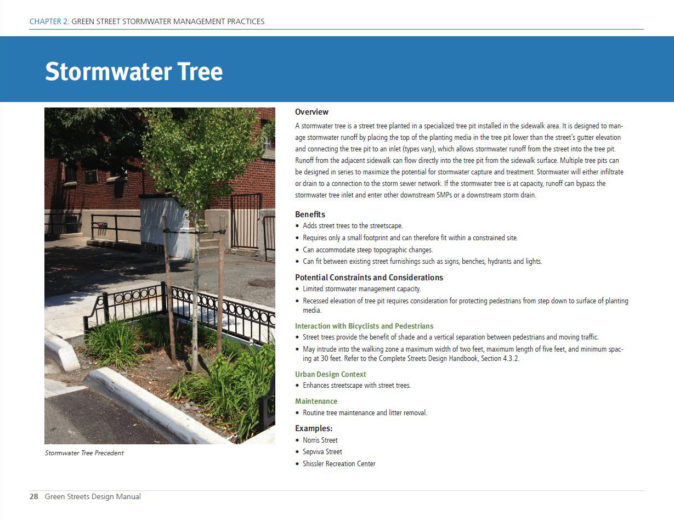
This is the first of two tree-and-soil design options that the plan covers. There are some elements here that work, for example the larger-than-average tree opening (more on that later) and a reasonably large curb cut for stormwater from the street to enter. I’m guessing that the idea is that the tree bed itself can act as a forebay (this presumes adequate maintenance). But there are some serious elements missing from the design as well.
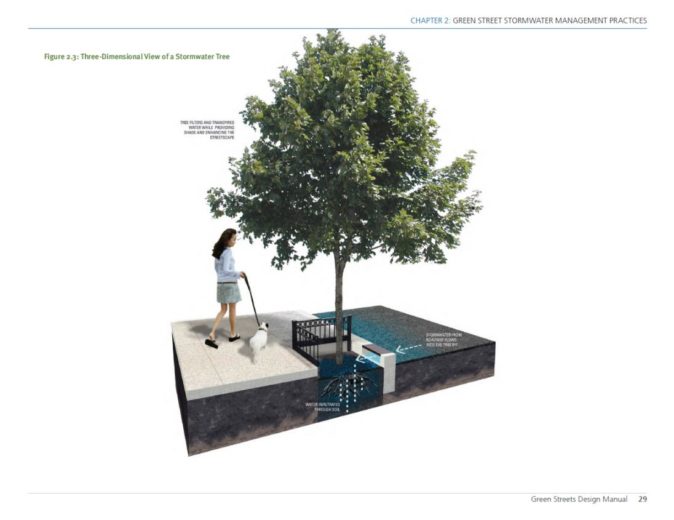
There is no mention of soil/media quality or quantity to grow the tree. As we already know, trees need soil – on the order of 1,000 cubic feet or more – in order to grow to maturity and provide significant ecosystem services. Soil is also an excellent tool for slowing, cleaning, and retaining stormwater on-site. The drawings don’t specify how much soil is required for a “Stormwater Tree,” so we can’t know for sure – but they don’t show much of it. What’s pictured in the manual looks just slightly larger than an average 3 foot-by-3 foot opening – and in fact, according to pages 6 and 7 of the appendix, 3 x 3 is the minimum size for a tree opening. This size opening provides roughly 30 cubic feet of soil – trees need about 30 times that amount to grow to maturity. Page 50 of the Manual’s Appendix shows geotextile wrapped around the root ball, further preventing tree roots from accessing any adjacent soil from nearby parks, lawns, or planters (Appendix 6.2: Design Components Specifications).
The second design option in the Green Streets Manual is a Stormwater Tree Trench.
Stormwater Tree Trench
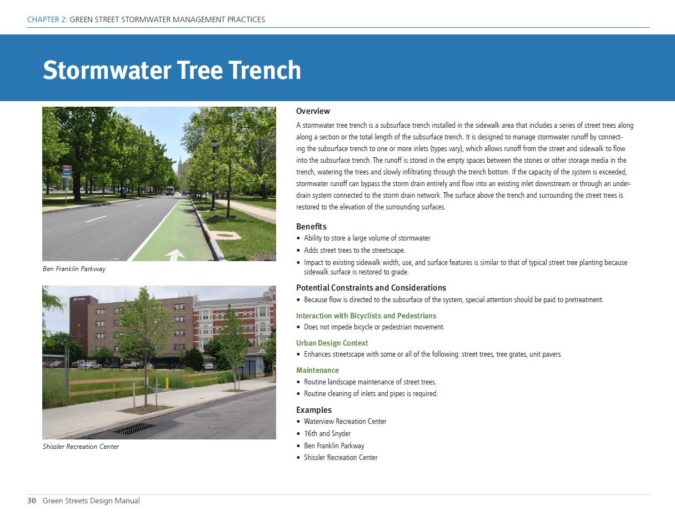
This is very similar to the Stormwater Tree – the main difference is that it applies to a series of trees, such as those along a street, that are connected by a belowground trench.
Again, there is no mention of soil/media quality or quantity to grow the tree. The image notes that the trench is made up of “stone or other storage media,” but the drawings in the Green Streets Manual clearly depict aggregate (see page 62 of the Appendix, 7.1.1 and 7.1.2). I could not find any description of a bioretention soil mix (or other storage media) in the document. Bioretention soils can typically use about 20 percent of their volume for water storage – less than aggregate, yes, but trees don’t grow in stone. And as trees grow, they can intercept and evaportanspire more and more water. This is a system that you would expect to improve and enhance its capacity year after year if the tree were growing and maturing each year.
While trees in shared soil volumes typically need less overall soil than single trees, the lack of required soil volumes remains a major oversight. There is also no suggested tree species list for a frequently flooded, occasionally droughty, chloride rich environment, and no tree trunk protection from street plows and sidewalk plows/brushes. Pre-treatment of stormwater is mentioned as a potential constraint/consideration, but should be given more attention.
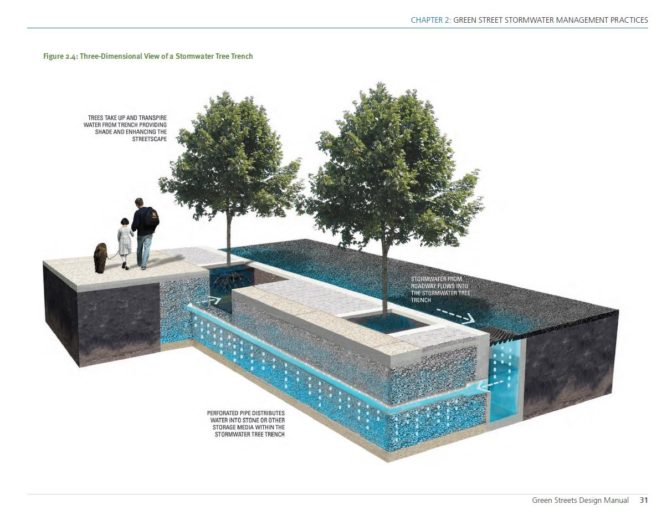
Neither the Stormwater Tree nor the Stormwater Tree Trench designs mention target volumes or actual media blends, both of which will greatly influence the performance and capacity of the system. There are no suggested tree species for a frequently flooded, occasionally droughty, chloride rich environment, and no tree trunk protection from street plows and sidewalk plows/brushes.
Soil can be a powerful media for slowing, retaining, and cleaning stormwater, but the document gives little attention to it. The Sizing Requirements section of the manual is the only part where I found a direct reference to the water-holding capacity of soils. Page 60 states: “Soil in a surface system has a porosity of 20 percent” (it does not mention the porosity classification for aggregate). 20 percent storage is consistent with what we tell clients who want to use soil to help slow, capture, and treat surface runoff. But the Green Streets Manual only acknowledges soil in surface systems, which may not be viable in many tight urban areas, or for any number of other reasons. What is their take on soil in below ground systems? I have inquired with the Philadelphia Water Department to clarify this point. As of this writing I have not heard back.
The Philadelphia Green Streets Manual starts with this introduction: “Green stormwater infrastructure (GSI) includes a range of soil-water-plant systems that intercept stormwater, infiltrate a portion of it into the ground, evaporate a portion of it into the air, and in some cases, release a portion of the captured stormwater slowly back into the sewer collection system. GSI treats stormwater runoff as a resource to be incorporated into the urban environment instead of as a waste product requiring removal and treatment,” (page 15).
But significant ecosystem services benefits come from large trees, not small ones. According to a 2002 study by Dr. David Nowak, with the USDA Forest Service, large, healthy trees greater than 77cm (30”) in diameter remove 70 times more air pollution annually than small, healthy trees less than 8cm (3”) in diameter. The tree-and-stormwater pits and trenches, which don’t specify required soil volumes, aren’t designed for mature tree growth. Attendant “ecosystem benefits” from interception and evapotranspiration are therefore unlikely. Similarly, aggregate – while good for stormwater storage – is not a growing media, and doesn’t clean runoff or slowly recharge groundwater.
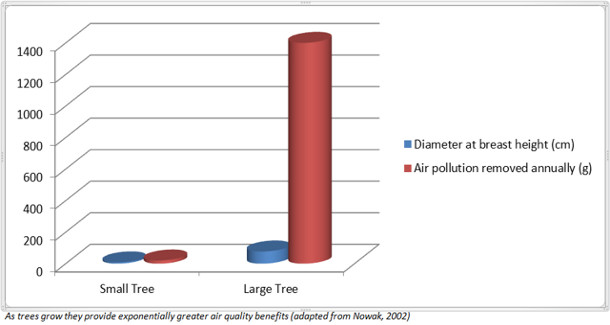
The plan is not all bad. And, like I said, I’m thrilled to see a green infrastructure policy being put forth by a major city and getting national attention for it. But their treatment of trees is more of the same magical thinking. We have the design tools to do better, and to be far, far more ambitious – for ourselves, for urban trees, and for our communities.
You can download the Green Streets Design Manual here.
Top image Flickr credit: rebekah
All other images: Philadelphia Green Streets Design Manual

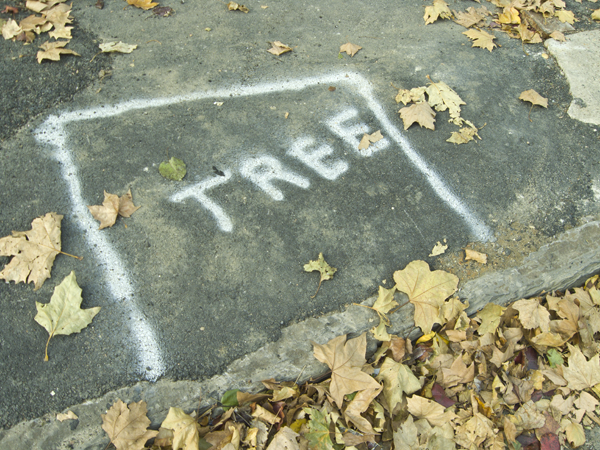
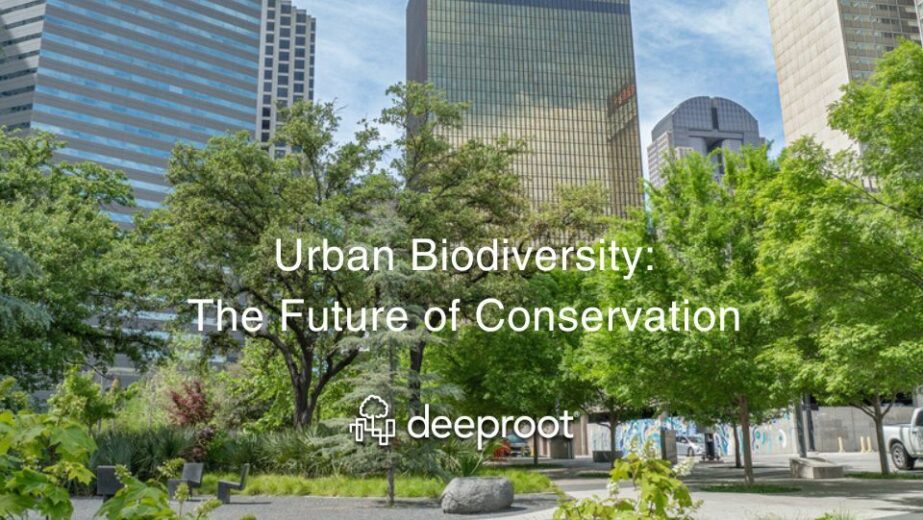



page 60 of this appendix specs an engineered soil for stormwater management practices: http://www.phillywatersheds.org/doc/GSI/GSDM_Appendix_FINAL_2014.pdf
I agree!